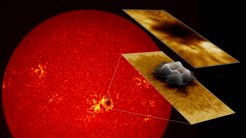Listening to the Symphony of Sunspots
Sunspots excite magneto-acoustic waves; a team of researchers has now discovered the largest-scale oscillations of this kind in an intense sunspot.
Stars like the Sun resonate like a giant water-filled balloon. In addition to these global acoustic oscillations that span the entire star, others are also known: Sunspots, dark regions on the Sun's surface, for example, can be the starting point for magneto-acoustic waves. Using the Dunn Solar Telescope in New Mexico (USA) an international group of researchers including the Max Planck Institute for Solar System Research (MPS) has for the first time observed a large number of such oscillations in connection with an exceptionally large sunspot. The sunspot covers up to 40,000 kilometers on the Sun’s surface, more than three times the Earth’s diameter. The team’s numerical modeling confirms this finding. The results are reported in the journal Nature Communications.

Sunspots are areas of high magnetic field strength on the visible surface of our star. Because the strong magnetic fields there prevent hot plasma from rising from the Sun's interior, sunspots appear dark as compared to their surroundings. They can be stable for several days or weeks. During periods of high solar activity, they occur frequently; during periods of low activity, the surface of the Sun may be completely devoid of sunspots for several months.
Theoretical models dating back 40 years suggest that the complex interplay of flowing plasma and magnetic fields beneath sunspots can excite a variety of so-called magneto-acoustic waves that propagate into the Sun's atmosphere. They are similar to pressure waves, but the magnetic forces acting on the solar plasma also play an important role. Depending on its size and magnetic field strength, each sunspot produces a different set of oscillations - and can thus be characterized by its own "sunspot symphony."
However, the "music of sunspots" has proven to be elusive: So far, only a few types of oscillations have been observed in small magnetic structures. The current study, led by the Italian space agency ASI and involving a total of twelve research institutions from six countries, now paints the first comprehensive picture of the oscillations associated with a giant sunspot.
Huge sunspot, huge magnetic field
For this purpose, the researchers analyzed observational data from the Dunn Solar Telescope from May 2016. At that time, the Sun had already passed its last activity maximum, but still showed a high level of activity. Near the solar equator, it sported a particularly large sunspot: with a diameter of about 40,000 kilometers, it was one of the largest of the past 20 years. Its magnetic field was also enormous. With a strength of 3.5 kilo Gauss, it exceeded Earth's magnetic field by about four orders of magnitude. "The high temporal and spatial resolution of the Dunn Solar Telescope, together with the strong magnetic field, provided us with unique data," explains Dr. Shahin Jafarzadeh of the MPS, who was involved in the study.
Analysis of the observational data spanning about three hours on May 20, 2016, revealed a broad spectrum of oscillations: more than 30 characteristic magneto-acoustic waves could be identified, many of which, like the sunspot itself, cover up to 40,000 kilometers. Numerical simulations by the researchers confirm these results.
Magneto-helioseismology and other applications
Since the newly detected oscillations continue into the Sun's atmosphere, the researchers believe they can help to better understand the Sun's energy transport into these outer layers. In addition, the oscillations could serve as the basis for magneto-helioseismological studies: the way in which the waves propagate through the sunspot could be used to infer the structure and dynamical processes in this region. The team is now hoping for further high-resolution observational data to continue their studies. These could be provided by ESA's Solar Orbiter spacecraft, which will travel within a distance of approximately 42 million kilometers of the Sun in the next few years, as well as by the recently completed Daniel K. Inouye Solar Telescope on Hawaii.












